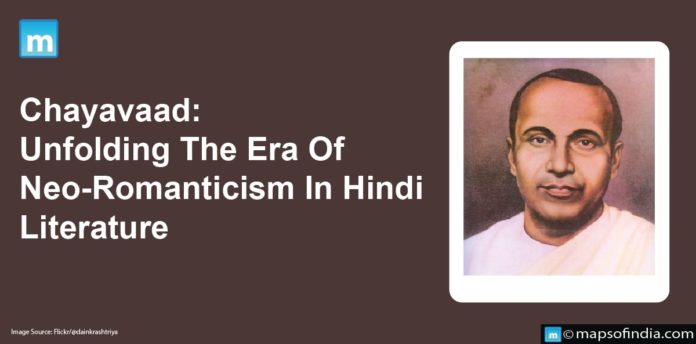“Woman, you are love incarnated, Under the silver mountain of faith.”
The powerful words of Jaishankar Prasad shall prevail under every light of the sun and moon. The world of Hindi literature has bestowed us with quite many great personalities. From the Renaissance of Bhartendu Harischand, Bhakti of Kabir to Contemporary scribbles of Khariboli Hindi, we have breathed the effervescent magnificence of literary life through centuries, honoring the revered poets and scholars. All of the phases in Hindi literature have been of utmost importance blending in unique artistry. Chayavad is one of those phases that showered us with some of the greatest minds in the history of literature.
Chayavad came after the period of the Renaissance and the slight hint of a didactic phase just before it. It is deemed the phase of neo-romanticism, an oscillation of succumbness towards romanticism with establishing a subtle connection between humans and nature.
Chhayavadi Yug
The phase of Chhayavad descended upon Hindi literature by 1922 and lasted till 1938. The era was marked by a swerve away from usual didacticism and formalism and towards romanticism and humanist temperament in the work of writers. The writings from the period verbosely display a newfound sense of self-expression, molding a personalized theme in its essence.
The period also drew a substantial influence from the happenings of its surroundings, which points towards the freedom struggle of the age. The poets of the Chhayavad generation seemed to profoundly tie an emotional connection with the cause of national freedom. Their poetries called upon the vast ancient culture of the nation, its tall-standing heritage, and the solemnity of Indian history. A magnificent glimpse of this expression can be felt in the lines of Jayshankar Prasad’s “Himadri Tung Shring Se”.
Four Pillars Of Chhayavaad
The era witnessed the rise of many great minds and poets, all leaving a dignified mark on the world of Hindi literature. But amongst them, four of the poets were deemed as the Four Pillars (Char Stambh) of Chayavadi school in Hindi Literature. Jaishankar Prasad, Sumitranandan Pant, Mahadevi Varma, and Suryakant Tripathi Nirala are the prominent poets from the age.
-
Jaishankar Prasad
The initial writings of Prasad were in “Braj” under the pen name of Kaladhar, but his later works were all in Khadi Boli Hindi, the Sanskritized form of Hindi. He curated Kamayani in 1936, which is the magnum opus of the Chayavad generation. His works were celebrated and worshiped in great delight, with poets like Mahadevi Verma drawing inspiration from him.
-
Sumitranandan Pant
Pant embarked on his voyage of literature in the soft age of seven, and Veena is the collection of the works he wrote since then. The poet is classically deemed as “the poet of nature” due to the continuous emphasis on nature reflected in his works.
“All come to find happiness and enjoyment. You have come to find the truth; Others are the effigy of the earth, You are the soul, the mind of the mind.” Pant dropped out of college to join the Satyagraha movement, and above are his lines of dedication toward Mahatma Gandhi.
-
Suryakant Tripathi Nirala
The poet has roots in Bengal but was brought to mainstream Hindi literature by his fondness for Sanskrit. Although Hindi was the third language of Nirala, his works became massive literary masterpieces.
-
Mahadevi Verma
The artistic profanity of Mahadevi Verma isn’t limited to one generation but surpasses all time and space. Shubhadra Kumari Chauhan was the mentor to Verma, who excelled in the art of Khadi Boli. The poetess is the first woman to have been honored with the Sahitya Akademi award, along with being the receiver of Padma Vibhushan.
Harishvansh Rai Bachchan, Ramdhari Singh Dinkar are the other prominent writers of the generation who marked their ink in a revolutionary patriotic upsurge that painted a never-ending inspiration for poets of all generations.




